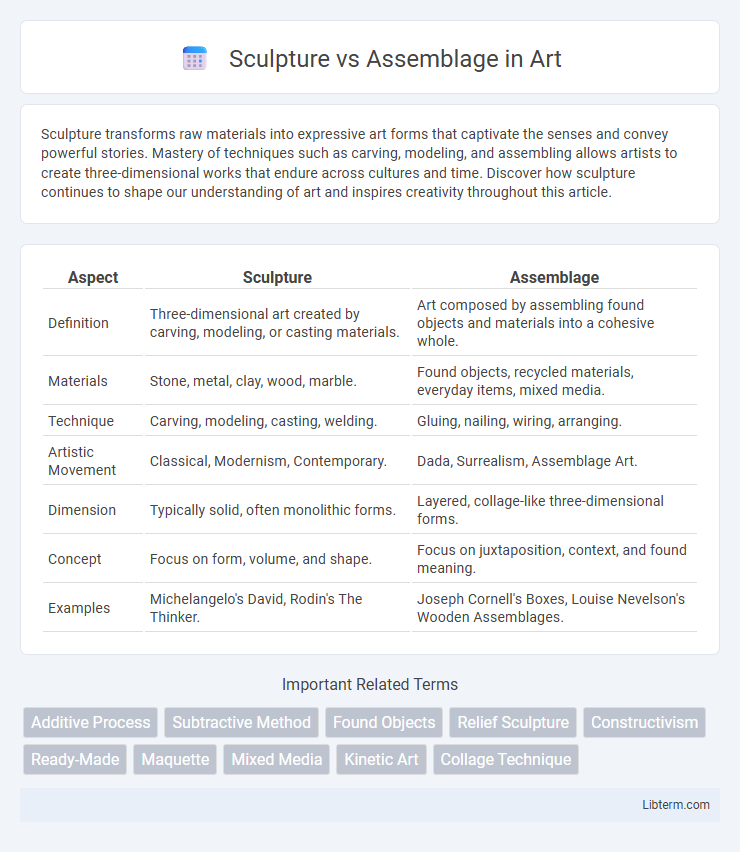Sculpture transforms raw materials into expressive art forms that captivate the senses and convey powerful stories. Mastery of techniques such as carving, modeling, and assembling allows artists to create three-dimensional works that endure across cultures and time. Discover how sculpture continues to shape our understanding of art and inspires creativity throughout this article.
Table of Comparison
| Aspect | Sculpture | Assemblage |
|---|---|---|
| Definition | Three-dimensional art created by carving, modeling, or casting materials. | Art composed by assembling found objects and materials into a cohesive whole. |
| Materials | Stone, metal, clay, wood, marble. | Found objects, recycled materials, everyday items, mixed media. |
| Technique | Carving, modeling, casting, welding. | Gluing, nailing, wiring, arranging. |
| Artistic Movement | Classical, Modernism, Contemporary. | Dada, Surrealism, Assemblage Art. |
| Dimension | Typically solid, often monolithic forms. | Layered, collage-like three-dimensional forms. |
| Concept | Focus on form, volume, and shape. | Focus on juxtaposition, context, and found meaning. |
| Examples | Michelangelo's David, Rodin's The Thinker. | Joseph Cornell's Boxes, Louise Nevelson's Wooden Assemblages. |
Introduction to Sculpture and Assemblage
Sculpture is a three-dimensional art form created by shaping materials like stone, metal, or wood to represent figures or abstract forms. Assemblage involves constructing artwork by assembling found objects or non-traditional materials into cohesive compositions that challenge conventional sculpture. Both techniques explore spatial relationships and materiality but differ in their approaches to form and texture.
Defining Sculpture: Traditional Concepts
Sculpture traditionally refers to three-dimensional artworks created by carving, modeling, or casting materials such as stone, clay, or metal to represent form and volume. It emphasizes craftsmanship in shaping solid materials into figures or abstract forms with a focus on physical presence and spatial relationships. This conventional approach contrasts with assemblage, which involves combining found objects and mixed media into sculptural compositions.
What Is Assemblage in Art?
Assemblage in art is a three-dimensional composition created by combining found objects, often disparate and everyday materials, into a unified whole, distinguishing it from traditional sculpture that typically involves carving or modeling a single medium like stone or clay. This technique originated in the early 20th century with artists like Pablo Picasso and Marcel Duchamp, emphasizing conceptual creativity through the juxtaposition of various elements. Assemblage challenges conventional artistic boundaries by integrating non-art materials to convey complex narratives and abstract ideas, expanding the definition of sculpture beyond classical forms.
Historical Roots: Sculpture vs Assemblage
Sculpture traces its historical roots to ancient civilizations such as Mesopotamia and Egypt, where artists carved stone and cast metal to create three-dimensional forms representing gods and rulers. Assemblage emerged in the early 20th century, closely linked to modern art movements like Dada and Surrealism, emphasizing the combination of found objects into new compositions that challenge traditional notions of sculpture. This evolution reflects a shift from classical techniques rooted in carving and modeling to experimental approaches that integrate everyday materials and conceptual frameworks.
Materials and Techniques Compared
Sculpture traditionally employs materials such as stone, metal, wood, and clay, requiring techniques like carving, modeling, and casting to shape forms. Assemblage uses found objects and mixed media, combining everyday items through methods like welding, gluing, and fastening to create three-dimensional compositions. While sculpture emphasizes transformation of raw materials, assemblage focuses on recontextualizing existing objects into new artistic expressions.
Exploring Artistic Intentions
Sculpture emphasizes the creation of three-dimensional forms through carving, modeling, or casting, allowing artists to explore volume, texture, and spatial presence as expressions of their artistic intentions. Assemblage combines found objects and materials, encouraging a dialogue between disparate elements to convey conceptual messages or social commentary. Both mediums reflect distinct approaches to materiality and meaning, revealing the artist's intent to manipulate perception and evoke emotional or intellectual responses.
Iconic Examples of Sculpture and Assemblage
Iconic sculptures like Michelangelo's David and Rodin's The Thinker exemplify traditional carving and modeling techniques emphasizing form and anatomical precision. Assemblage art, highlighted by Pablo Picasso's "Guitar" and Louise Nevelson's "Sky Cathedral," combines found objects to create three-dimensional compositions, emphasizing texture and conceptual depth. These examples illustrate the sculpture's focus on shaping materials versus assemblage's emphasis on recontextualizing everyday items.
Contemporary Approaches and Innovations
Contemporary sculpture integrates traditional materials like bronze and marble with unconventional elements such as found objects and industrial components, pushing the boundaries of form and meaning. Assemblage art, characterized by the combination of disparate materials into cohesive three-dimensional works, challenges conventional notions by emphasizing texture, context, and narrative complexity. Innovative approaches in both mediums often involve interactive technology, mixed media, and site-specific installations, reflecting evolving artistic paradigms and viewer engagement in modern gallery and public spaces.
Viewer Experience: Perception and Interaction
Sculpture invites viewers to engage with form, volume, and spatial relationships through a primarily three-dimensional and often tactile experience that emphasizes materiality and craftsmanship. Assemblage challenges traditional perception by integrating found objects and diverse materials, encouraging active interpretation and often evoking layered narratives through juxtaposition. Interaction with assemblages can be more dynamic, as viewers decode symbolic meanings and contextual contrasts, resulting in a multifaceted sensory and cognitive engagement.
Conclusion: The Evolving Boundaries of Three-Dimensional Art
Sculpture and assemblage both redefine three-dimensional art through distinct methods--sculpture traditionally involves carving or modeling materials, while assemblage constructs forms from found objects. The evolving boundaries between these art forms highlight a shift towards hybrid practices that challenge conventional classifications. Contemporary artists increasingly merge techniques, expanding the scope and conceptual depth of spatial expression.
Sculpture Infographic

 libterm.com
libterm.com